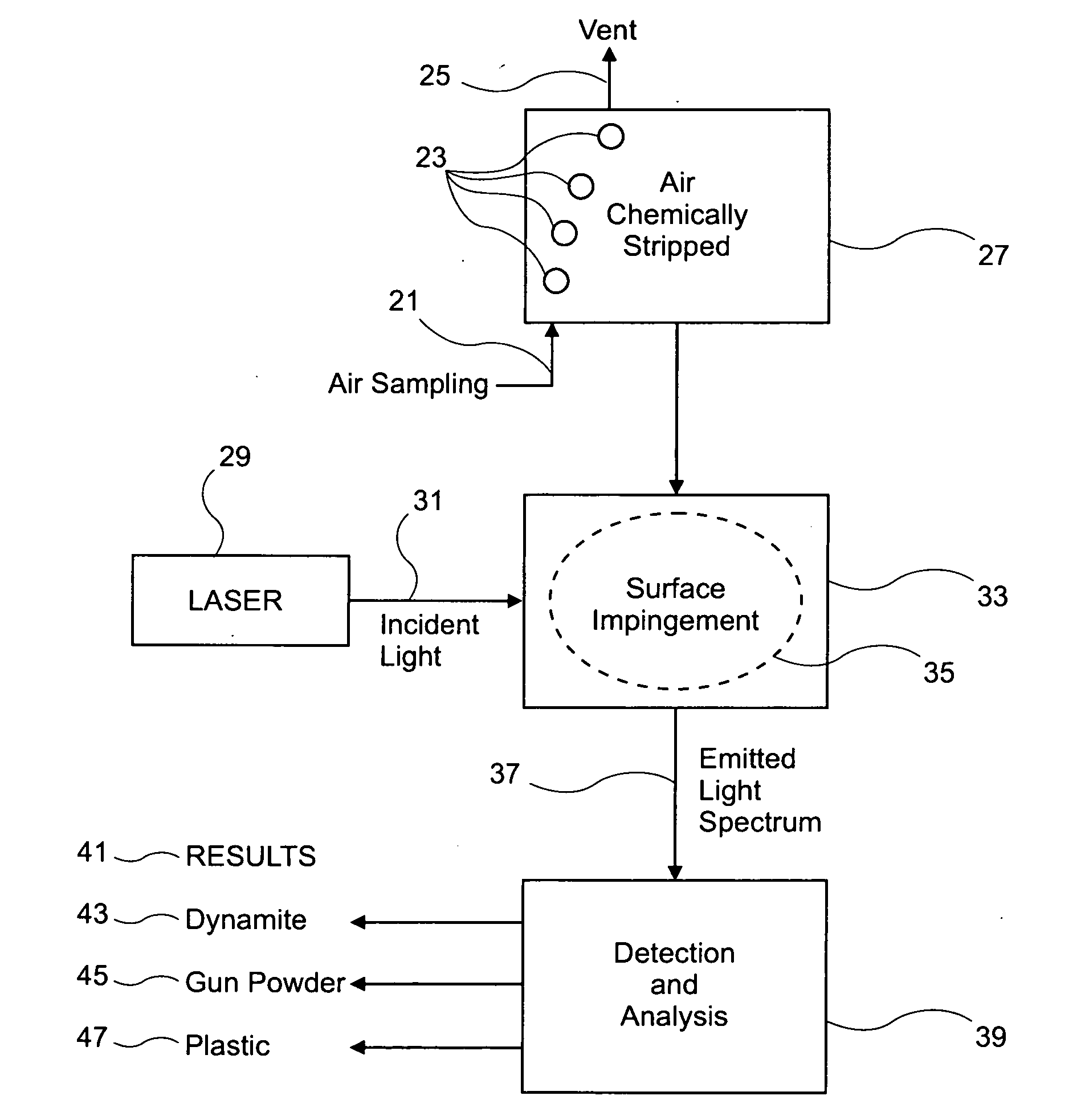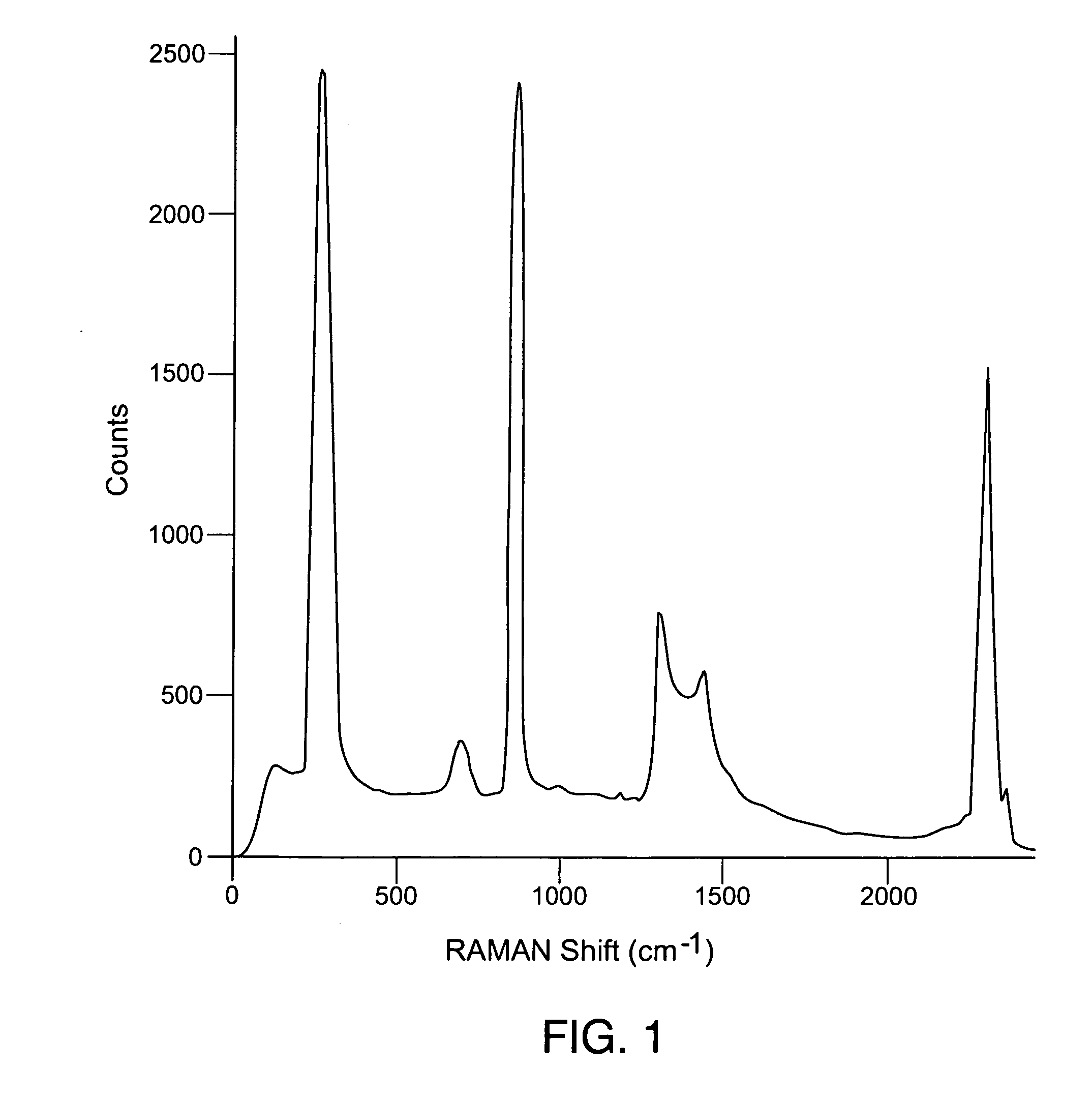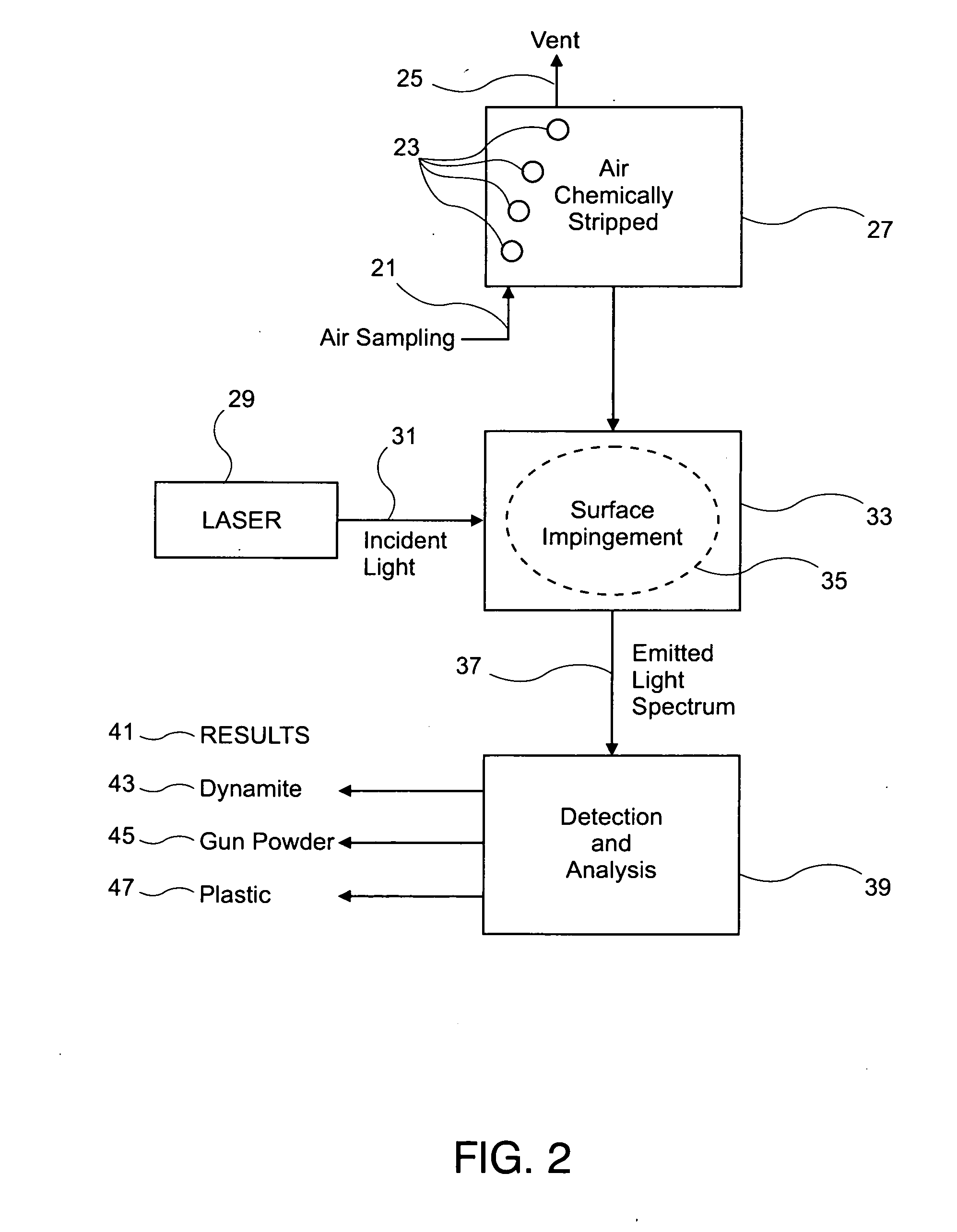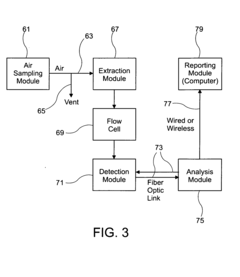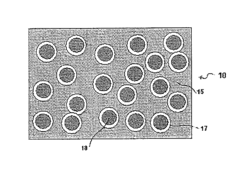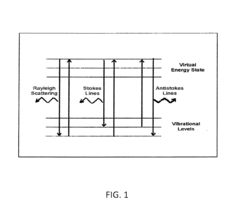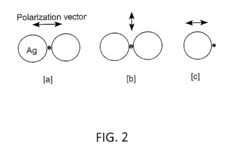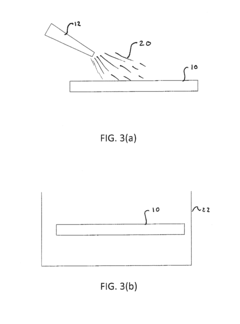How to Enhance Raman Spectroscopy for Environmental Toxins
SEP 19, 20259 MIN READ
Generate Your Research Report Instantly with AI Agent
Patsnap Eureka helps you evaluate technical feasibility & market potential.
Raman Spectroscopy Evolution and Detection Goals
Raman spectroscopy has evolved significantly since its discovery by C.V. Raman in 1928, transforming from a purely scientific tool into a versatile analytical technique with diverse applications. The initial decades following its discovery were characterized by fundamental research and theoretical development, with limited practical applications due to technological constraints. The advent of lasers in the 1960s marked a pivotal turning point, providing the intense monochromatic light source necessary for efficient Raman scattering detection.
The 1970s and 1980s witnessed the emergence of Fourier Transform Raman Spectroscopy, which addressed fluorescence interference issues that had previously limited the technique's applicability. By the 1990s, Surface-Enhanced Raman Spectroscopy (SERS) began gaining traction, offering significantly enhanced sensitivity through plasmonic effects on metallic surfaces, thereby expanding the technique's potential for trace analysis of environmental contaminants.
The early 2000s saw the development of portable Raman spectrometers, transitioning the technology from laboratory-confined instruments to field-deployable devices. This mobility breakthrough enabled in-situ environmental monitoring capabilities, particularly valuable for rapid assessment of contamination sites. Concurrently, computational advances facilitated more sophisticated data processing algorithms, improving spectral resolution and analyte identification accuracy.
Recent technological trends include the integration of Raman spectroscopy with complementary techniques such as mass spectrometry and chromatography, creating powerful hybrid analytical platforms. Additionally, the miniaturization of components has led to handheld devices capable of real-time analysis, while advances in nanomaterials have further enhanced detection sensitivity through novel SERS substrates and tip-enhanced Raman spectroscopy (TERS) approaches.
The primary detection goals for environmental toxin analysis using Raman spectroscopy encompass several critical objectives. Foremost is achieving parts-per-billion sensitivity for persistent organic pollutants, heavy metals, and emerging contaminants in complex environmental matrices. Equally important is developing robust field-deployable systems capable of real-time monitoring with minimal sample preparation requirements, enabling rapid response to contamination events.
Additional goals include expanding the range of detectable environmental toxins through comprehensive spectral libraries and machine learning algorithms for pattern recognition. The technology aims to overcome current limitations in analyzing complex environmental samples containing multiple interfering substances, particularly in challenging matrices such as sediments and biological tissues. Ultimately, the field strives toward creating integrated monitoring networks utilizing Raman technology for continuous environmental surveillance with automated alert systems for exceeding regulatory thresholds.
The 1970s and 1980s witnessed the emergence of Fourier Transform Raman Spectroscopy, which addressed fluorescence interference issues that had previously limited the technique's applicability. By the 1990s, Surface-Enhanced Raman Spectroscopy (SERS) began gaining traction, offering significantly enhanced sensitivity through plasmonic effects on metallic surfaces, thereby expanding the technique's potential for trace analysis of environmental contaminants.
The early 2000s saw the development of portable Raman spectrometers, transitioning the technology from laboratory-confined instruments to field-deployable devices. This mobility breakthrough enabled in-situ environmental monitoring capabilities, particularly valuable for rapid assessment of contamination sites. Concurrently, computational advances facilitated more sophisticated data processing algorithms, improving spectral resolution and analyte identification accuracy.
Recent technological trends include the integration of Raman spectroscopy with complementary techniques such as mass spectrometry and chromatography, creating powerful hybrid analytical platforms. Additionally, the miniaturization of components has led to handheld devices capable of real-time analysis, while advances in nanomaterials have further enhanced detection sensitivity through novel SERS substrates and tip-enhanced Raman spectroscopy (TERS) approaches.
The primary detection goals for environmental toxin analysis using Raman spectroscopy encompass several critical objectives. Foremost is achieving parts-per-billion sensitivity for persistent organic pollutants, heavy metals, and emerging contaminants in complex environmental matrices. Equally important is developing robust field-deployable systems capable of real-time monitoring with minimal sample preparation requirements, enabling rapid response to contamination events.
Additional goals include expanding the range of detectable environmental toxins through comprehensive spectral libraries and machine learning algorithms for pattern recognition. The technology aims to overcome current limitations in analyzing complex environmental samples containing multiple interfering substances, particularly in challenging matrices such as sediments and biological tissues. Ultimately, the field strives toward creating integrated monitoring networks utilizing Raman technology for continuous environmental surveillance with automated alert systems for exceeding regulatory thresholds.
Environmental Toxin Monitoring Market Analysis
The global environmental toxin monitoring market is experiencing robust growth, driven by increasing awareness of environmental pollution and its impact on public health. Currently valued at approximately 4.2 billion USD, this market is projected to grow at a compound annual growth rate of 7.8% through 2028, reflecting the urgent need for advanced detection technologies like enhanced Raman spectroscopy solutions.
Water quality monitoring represents the largest segment, accounting for nearly 38% of the market share, followed by air quality monitoring at 29% and soil contamination detection at 22%. The remaining 11% encompasses specialized applications including food safety testing and industrial effluent analysis. This distribution highlights the diverse application potential for advanced Raman spectroscopy techniques across multiple environmental matrices.
Geographically, North America dominates the market with 34% share, followed closely by Europe at 31%. The Asia-Pacific region, however, is demonstrating the fastest growth rate at 9.3% annually, driven by rapid industrialization, stringent environmental regulations, and increasing public health concerns in countries like China and India. This regional growth pattern presents significant opportunities for technology deployment in emerging markets.
From an end-user perspective, government environmental agencies remain the primary customers, representing 42% of the market. Industrial sectors collectively account for 36%, with particular demand from chemical manufacturing, mining, and agricultural industries. Research institutions and environmental consulting firms comprise the remaining 22%, often serving as early adopters of innovative technologies like advanced Raman spectroscopy systems.
Key market drivers include increasingly stringent environmental regulations worldwide, growing public awareness of pollution-related health risks, and technological advancements enabling more accurate, portable, and cost-effective detection methods. The COVID-19 pandemic has further accelerated market growth by heightening awareness about environmental health connections and stimulating investment in monitoring infrastructure.
Significant market restraints include the high cost of advanced analytical equipment, technical complexity requiring specialized training, and challenges in standardizing detection protocols across different environmental matrices. For Raman spectroscopy specifically, current limitations in sensitivity for trace contaminant detection and interference from environmental matrices represent key barriers to wider adoption that technological enhancements must address.
Customer demand increasingly focuses on portable, field-deployable systems capable of real-time or near-real-time analysis, with 68% of potential buyers citing this as a critical purchasing factor. Additionally, 73% of customers express strong interest in multi-contaminant detection capabilities, highlighting the market opportunity for versatile Raman spectroscopy platforms that can identify diverse environmental toxins simultaneously.
Water quality monitoring represents the largest segment, accounting for nearly 38% of the market share, followed by air quality monitoring at 29% and soil contamination detection at 22%. The remaining 11% encompasses specialized applications including food safety testing and industrial effluent analysis. This distribution highlights the diverse application potential for advanced Raman spectroscopy techniques across multiple environmental matrices.
Geographically, North America dominates the market with 34% share, followed closely by Europe at 31%. The Asia-Pacific region, however, is demonstrating the fastest growth rate at 9.3% annually, driven by rapid industrialization, stringent environmental regulations, and increasing public health concerns in countries like China and India. This regional growth pattern presents significant opportunities for technology deployment in emerging markets.
From an end-user perspective, government environmental agencies remain the primary customers, representing 42% of the market. Industrial sectors collectively account for 36%, with particular demand from chemical manufacturing, mining, and agricultural industries. Research institutions and environmental consulting firms comprise the remaining 22%, often serving as early adopters of innovative technologies like advanced Raman spectroscopy systems.
Key market drivers include increasingly stringent environmental regulations worldwide, growing public awareness of pollution-related health risks, and technological advancements enabling more accurate, portable, and cost-effective detection methods. The COVID-19 pandemic has further accelerated market growth by heightening awareness about environmental health connections and stimulating investment in monitoring infrastructure.
Significant market restraints include the high cost of advanced analytical equipment, technical complexity requiring specialized training, and challenges in standardizing detection protocols across different environmental matrices. For Raman spectroscopy specifically, current limitations in sensitivity for trace contaminant detection and interference from environmental matrices represent key barriers to wider adoption that technological enhancements must address.
Customer demand increasingly focuses on portable, field-deployable systems capable of real-time or near-real-time analysis, with 68% of potential buyers citing this as a critical purchasing factor. Additionally, 73% of customers express strong interest in multi-contaminant detection capabilities, highlighting the market opportunity for versatile Raman spectroscopy platforms that can identify diverse environmental toxins simultaneously.
Current Limitations in Raman-Based Toxin Detection
Despite the promising capabilities of Raman spectroscopy for environmental toxin detection, several significant limitations currently hinder its widespread application and effectiveness in real-world environmental monitoring scenarios. These constraints span technical, practical, and analytical domains that collectively reduce the technique's sensitivity and applicability.
The most prominent technical limitation is the inherently weak Raman signal, with typical scattering efficiencies approximately 10^-6 times weaker than fluorescence. This fundamental weakness makes detecting trace amounts of environmental toxins particularly challenging, especially in complex environmental matrices where target analytes may be present at parts-per-billion or parts-per-trillion concentrations.
Interference from background fluorescence presents another major obstacle. Many environmental samples contain naturally fluorescent compounds that produce broad spectral backgrounds, effectively masking the weaker Raman signals of target toxins. This problem is particularly acute when analyzing water samples containing dissolved organic matter or soil samples with high humic substance content.
Sample complexity further complicates toxin detection, as environmental matrices typically contain numerous compounds that can produce overlapping Raman bands. This spectral congestion makes it difficult to isolate and identify specific toxin signatures without sophisticated data processing techniques or sample preparation methods that may alter the original sample composition.
Current instrumentation also imposes practical limitations. Most high-sensitivity Raman systems remain laboratory-bound, expensive, and require specialized operation expertise. Portable field-deployable systems generally sacrifice sensitivity and spectral resolution, limiting their effectiveness for environmental monitoring applications where detection of low toxin concentrations is critical.
Data interpretation challenges constitute another significant barrier. The complexity of environmental sample spectra often necessitates advanced chemometric approaches and machine learning algorithms for accurate toxin identification and quantification. However, current algorithms frequently struggle with variable environmental conditions and matrix effects that can alter spectral features.
Standardization issues further complicate reliable toxin detection across different laboratories and instruments. The lack of universally accepted protocols for sample preparation, measurement parameters, and data processing creates inconsistencies in results and hinders comparative studies between different research groups and monitoring programs.
Lastly, there remains a significant gap in comprehensive spectral libraries specifically for environmental toxins across various matrices. While databases exist for certain compound classes, they often lack the diversity needed to account for the wide range of environmental conditions and sample types encountered in real-world monitoring scenarios.
The most prominent technical limitation is the inherently weak Raman signal, with typical scattering efficiencies approximately 10^-6 times weaker than fluorescence. This fundamental weakness makes detecting trace amounts of environmental toxins particularly challenging, especially in complex environmental matrices where target analytes may be present at parts-per-billion or parts-per-trillion concentrations.
Interference from background fluorescence presents another major obstacle. Many environmental samples contain naturally fluorescent compounds that produce broad spectral backgrounds, effectively masking the weaker Raman signals of target toxins. This problem is particularly acute when analyzing water samples containing dissolved organic matter or soil samples with high humic substance content.
Sample complexity further complicates toxin detection, as environmental matrices typically contain numerous compounds that can produce overlapping Raman bands. This spectral congestion makes it difficult to isolate and identify specific toxin signatures without sophisticated data processing techniques or sample preparation methods that may alter the original sample composition.
Current instrumentation also imposes practical limitations. Most high-sensitivity Raman systems remain laboratory-bound, expensive, and require specialized operation expertise. Portable field-deployable systems generally sacrifice sensitivity and spectral resolution, limiting their effectiveness for environmental monitoring applications where detection of low toxin concentrations is critical.
Data interpretation challenges constitute another significant barrier. The complexity of environmental sample spectra often necessitates advanced chemometric approaches and machine learning algorithms for accurate toxin identification and quantification. However, current algorithms frequently struggle with variable environmental conditions and matrix effects that can alter spectral features.
Standardization issues further complicate reliable toxin detection across different laboratories and instruments. The lack of universally accepted protocols for sample preparation, measurement parameters, and data processing creates inconsistencies in results and hinders comparative studies between different research groups and monitoring programs.
Lastly, there remains a significant gap in comprehensive spectral libraries specifically for environmental toxins across various matrices. While databases exist for certain compound classes, they often lack the diversity needed to account for the wide range of environmental conditions and sample types encountered in real-world monitoring scenarios.
Existing Enhancement Methods for Raman Sensitivity
01 Surface-Enhanced Raman Spectroscopy (SERS) Techniques
Surface-Enhanced Raman Spectroscopy utilizes metallic nanostructures to amplify Raman signals through electromagnetic field enhancement. This technique can increase sensitivity by several orders of magnitude, allowing detection of trace amounts of analytes. Various substrate designs including nanoparticles, roughened surfaces, and patterned arrays are employed to optimize the enhancement effect, making it valuable for chemical and biological sensing applications.- Surface-Enhanced Raman Spectroscopy (SERS) Techniques: Surface-Enhanced Raman Spectroscopy (SERS) utilizes metallic nanostructures to amplify Raman signals by several orders of magnitude. These techniques involve the use of specially designed substrates with noble metal nanoparticles or nanostructured surfaces that create localized surface plasmon resonance, significantly enhancing the Raman scattering effect. This enhancement allows for detection of molecules at much lower concentrations than conventional Raman spectroscopy, making it valuable for trace analysis applications.
- Tip-Enhanced Raman Spectroscopy (TERS) Methods: Tip-Enhanced Raman Spectroscopy combines the high spatial resolution of scanning probe microscopy with the chemical specificity of Raman spectroscopy. It uses a metallized tip positioned very close to the sample surface to create a localized enhancement of the electromagnetic field. This approach enables nanoscale chemical imaging with resolution far beyond the diffraction limit, allowing for molecular characterization at the nanometer scale. TERS is particularly valuable for surface science, materials research, and biological applications requiring high spatial resolution.
- Nanoparticle-Based Enhancement Systems: Specialized nanoparticles are designed to enhance Raman signals through various mechanisms including plasmonic effects. These systems utilize gold, silver, or other metallic nanoparticles with controlled size, shape, and composition to optimize the enhancement effect. Some approaches involve core-shell structures, nanoparticle aggregates, or functionalized particles that can target specific analytes. These nanoparticle systems can be used in solution or as substrates, providing flexible platforms for various analytical applications.
- Instrumentation and Hardware Innovations: Advanced instrumentation designs improve Raman signal detection and processing capabilities. These innovations include specialized optical configurations, improved detectors with higher sensitivity and lower noise, laser sources with optimized wavelengths and power, and integrated systems that combine Raman with other analytical techniques. Some designs focus on miniaturization for portable applications, while others emphasize high-throughput screening or automated analysis. These hardware improvements enable more sensitive, faster, and more reliable Raman measurements.
- Data Processing and Signal Enhancement Algorithms: Computational methods enhance Raman spectral data quality and information extraction. These approaches include advanced signal processing algorithms to reduce noise and background interference, multivariate statistical methods for spectral analysis, machine learning techniques for pattern recognition and classification, and chemometric methods for quantitative analysis. Some algorithms focus on deconvolution of overlapping spectral features or automated peak identification. These computational enhancements improve the sensitivity, specificity, and reliability of Raman spectroscopic analysis.
02 Tip-Enhanced Raman Spectroscopy (TERS)
Tip-Enhanced Raman Spectroscopy combines scanning probe microscopy with Raman spectroscopy to achieve nanoscale spatial resolution. By using a metallic tip as a local field enhancer, TERS can provide chemical information with resolution beyond the diffraction limit. This technique enables molecular characterization at the nanometer scale and is particularly useful for surface science, materials research, and biological sample analysis.Expand Specific Solutions03 Resonance Raman Enhancement Methods
Resonance Raman techniques exploit the electronic properties of molecules to enhance Raman scattering when the excitation wavelength matches or is close to an electronic transition of the analyte. This approach can provide signal enhancements of 10^3-10^6 and offers improved selectivity by preferentially enhancing vibrations associated with the resonant chromophore. The technique is particularly valuable for studying biological molecules, pigments, and conjugated systems with strong absorption bands.Expand Specific Solutions04 Nanostructured Materials for Raman Enhancement
Specialized nanostructured materials including metal nanoparticles, nanogaps, nanoholes, and core-shell structures are designed to maximize electromagnetic field enhancement for Raman spectroscopy. These materials create plasmonic hotspots where the Raman signal is dramatically amplified. Recent advances include the development of reproducible fabrication methods, tunable resonance properties, and substrates with uniform enhancement factors for quantitative analysis.Expand Specific Solutions05 Instrumentation and Data Processing for Enhanced Raman Detection
Advanced instrumentation and data processing techniques significantly improve Raman spectroscopy performance. Innovations include specialized optical configurations, laser stabilization systems, high-efficiency spectrometers, and sensitive detectors. Computational methods such as multivariate analysis, machine learning algorithms, and automated baseline correction enhance signal extraction from complex spectra. These approaches collectively improve detection limits, measurement speed, and reliability in challenging analytical environments.Expand Specific Solutions
Leading Companies and Research Institutions
The Raman spectroscopy market for environmental toxin detection is in a growth phase, with increasing adoption driven by rising environmental concerns. The market is projected to expand significantly as regulatory requirements for toxin monitoring become stricter worldwide. Technologically, the field shows varying maturity levels, with companies like Renishaw Plc and Renishaw Diagnostics leading commercial applications through advanced spectroscopic systems. Research institutions including Shanghai Jiao Tong University and Jiangsu Normal University are advancing fundamental capabilities, while corporations such as IBM and Intel are developing integrated computational solutions. SAFTRA photonics and Sword Diagnostics represent emerging players focusing on portable detection systems, indicating a trend toward field-deployable solutions that could significantly expand market applications.
Renishaw Plc
Technical Solution: Renishaw has developed advanced Raman spectroscopy systems specifically designed for environmental toxin detection. Their technology incorporates Surface-Enhanced Raman Spectroscopy (SERS) with specialized substrates that significantly amplify Raman signals from trace environmental contaminants. The company's InVia™ Raman microscope platform features high-sensitivity detectors and automated sampling systems that enable detection limits in the parts-per-billion range for various environmental pollutants[1]. Renishaw has also pioneered the integration of machine learning algorithms with their spectroscopic systems to improve signal processing and automated identification of complex toxin mixtures in environmental samples[3]. Their StreamLine™ technology enables rapid chemical mapping of samples, allowing researchers to visualize the spatial distribution of contaminants across environmental specimens with unprecedented detail and speed.
Strengths: Superior sensitivity for trace contaminant detection, robust automated analysis capabilities, and excellent spatial mapping resolution. Weaknesses: Higher cost compared to conventional systems, requires specialized training for optimal operation, and limited portability for field applications.
Renishaw Diagnostics Ltd.
Technical Solution:
Breakthrough Technologies in SERS and TERS
Enhancing Raman spectrographic sensitivity by using solvent extraction of vapor or particulate trace materials, improved surface scatter from nano-structures on nano-particles, and volumetric integration of the Raman scatter from the nano-particles' surfaces
PatentInactiveUS20080268548A1
Innovation
- A method utilizing a colloid with a liquid solvent and nano-sized noble metal particles as an impingement surface, enhancing Raman scattering by maximizing surface-to-volume interactions and employing solvent extraction to concentrate trace molecules, followed by laser illumination and spectroscopic analysis to generate and process Raman spectra for identification.
Method for the formation of SERS substrates
PatentInactiveUS20140017448A1
Innovation
- A method involving the application of a nanoparticle ink to a substrate, followed by heating to control the average distance between nanoparticles, forming fractal aggregates that enhance Raman scattering signals through controlled nanoparticle arrangement, allowing for scalable and cost-effective production of SERS substrates.
Regulatory Framework for Environmental Monitoring
The regulatory landscape for environmental monitoring using advanced technologies like Raman spectroscopy is complex and continuously evolving. At the international level, organizations such as the United Nations Environment Programme (UNEP) and the World Health Organization (WHO) establish guidelines for environmental toxin detection and monitoring. These frameworks provide baseline standards that influence national and regional regulatory approaches, particularly for persistent organic pollutants (POPs) and heavy metals.
In the United States, the Environmental Protection Agency (EPA) has established the Toxic Substances Control Act (TSCA) and the Comprehensive Environmental Response, Compensation, and Liability Act (CERCLA), which mandate specific detection thresholds and monitoring protocols for environmental toxins. The EPA Method 8330B specifically addresses spectroscopic techniques for environmental analysis, though Raman spectroscopy is still gaining recognition as a standardized method.
The European Union operates under the Registration, Evaluation, Authorization and Restriction of Chemicals (REACH) regulation, which imposes stringent requirements for chemical monitoring and reporting. The Water Framework Directive (2000/60/EC) further establishes comprehensive monitoring programs for aquatic environments, where Raman spectroscopy applications are increasingly relevant.
Emerging economies like China and India have recently strengthened their environmental monitoring frameworks. China's revised Environmental Protection Law and India's National Environmental Policy now incorporate more rigorous standards for toxin detection, creating new opportunities for advanced spectroscopic technologies.
A significant regulatory trend is the shift toward real-time monitoring requirements, with several jurisdictions now mandating continuous environmental surveillance rather than periodic sampling. This transition favors technologies like enhanced Raman spectroscopy that can provide rapid, on-site analysis capabilities.
Certification and validation protocols for new monitoring technologies represent another critical regulatory component. ISO standards, particularly ISO 17025 for testing laboratories, establish quality assurance frameworks that new Raman spectroscopy applications must satisfy to gain regulatory acceptance.
Data management regulations, including requirements for data integrity, storage, and sharing, also impact the implementation of spectroscopic monitoring systems. The increasing emphasis on public access to environmental data creates additional compliance considerations for organizations deploying these technologies.
As regulatory frameworks continue to evolve, there is growing recognition of the need for standardized protocols specifically addressing advanced spectroscopic methods like enhanced Raman techniques, which would facilitate wider adoption and regulatory acceptance of these promising technologies for environmental toxin monitoring.
In the United States, the Environmental Protection Agency (EPA) has established the Toxic Substances Control Act (TSCA) and the Comprehensive Environmental Response, Compensation, and Liability Act (CERCLA), which mandate specific detection thresholds and monitoring protocols for environmental toxins. The EPA Method 8330B specifically addresses spectroscopic techniques for environmental analysis, though Raman spectroscopy is still gaining recognition as a standardized method.
The European Union operates under the Registration, Evaluation, Authorization and Restriction of Chemicals (REACH) regulation, which imposes stringent requirements for chemical monitoring and reporting. The Water Framework Directive (2000/60/EC) further establishes comprehensive monitoring programs for aquatic environments, where Raman spectroscopy applications are increasingly relevant.
Emerging economies like China and India have recently strengthened their environmental monitoring frameworks. China's revised Environmental Protection Law and India's National Environmental Policy now incorporate more rigorous standards for toxin detection, creating new opportunities for advanced spectroscopic technologies.
A significant regulatory trend is the shift toward real-time monitoring requirements, with several jurisdictions now mandating continuous environmental surveillance rather than periodic sampling. This transition favors technologies like enhanced Raman spectroscopy that can provide rapid, on-site analysis capabilities.
Certification and validation protocols for new monitoring technologies represent another critical regulatory component. ISO standards, particularly ISO 17025 for testing laboratories, establish quality assurance frameworks that new Raman spectroscopy applications must satisfy to gain regulatory acceptance.
Data management regulations, including requirements for data integrity, storage, and sharing, also impact the implementation of spectroscopic monitoring systems. The increasing emphasis on public access to environmental data creates additional compliance considerations for organizations deploying these technologies.
As regulatory frameworks continue to evolve, there is growing recognition of the need for standardized protocols specifically addressing advanced spectroscopic methods like enhanced Raman techniques, which would facilitate wider adoption and regulatory acceptance of these promising technologies for environmental toxin monitoring.
Field Application Challenges and Solutions
Deploying Raman spectroscopy for environmental toxin detection in field conditions presents significant challenges that differ substantially from controlled laboratory environments. The primary obstacle is equipment portability, as traditional Raman systems typically require stable power sources, controlled temperature conditions, and vibration isolation. Recent developments in miniaturized spectrometers have addressed this issue partially, but further improvements in battery life and ruggedization are necessary for extended field operations in remote locations.
Environmental interference poses another major challenge, with ambient light, temperature fluctuations, and humidity affecting measurement accuracy. Advanced algorithms for background subtraction and adaptive calibration techniques have been developed to compensate for these variables, though their effectiveness varies across different field conditions. Implementation of weatherproof housings and automated environmental compensation systems represents a promising solution pathway currently being explored by several research teams.
Sample preparation remains problematic in field settings where laboratory techniques are impractical. Direct sampling methods often suffer from lower sensitivity due to matrix effects and interference from non-target compounds. Innovative approaches include the development of field-compatible solid-phase extraction techniques and microfluidic sample preparation systems that can concentrate toxins prior to analysis, significantly improving detection limits without requiring extensive laboratory infrastructure.
Signal enhancement presents another critical challenge, particularly for trace-level environmental toxins. Surface-enhanced Raman spectroscopy (SERS) substrates designed specifically for field use have shown promising results, with some commercial solutions now available that maintain stability under variable environmental conditions. These substrates typically employ nanostructured gold or silver surfaces that can be applied directly to environmental samples, enhancing signal strength by several orders of magnitude.
Data interpretation and analysis in real-time represents a significant hurdle for field applications. Machine learning algorithms trained on comprehensive spectral libraries have demonstrated success in automated identification of environmental toxins even in complex matrices. Cloud-connected systems that allow for remote data processing and expert consultation are becoming increasingly common, though connectivity issues in remote locations remain problematic.
Calibration and quality control procedures adapted for field use are essential for reliable results. Recent innovations include internal calibration standards that automatically compensate for instrument drift and environmental variations, ensuring measurement consistency across different field conditions and enabling meaningful comparison with laboratory reference methods.
Environmental interference poses another major challenge, with ambient light, temperature fluctuations, and humidity affecting measurement accuracy. Advanced algorithms for background subtraction and adaptive calibration techniques have been developed to compensate for these variables, though their effectiveness varies across different field conditions. Implementation of weatherproof housings and automated environmental compensation systems represents a promising solution pathway currently being explored by several research teams.
Sample preparation remains problematic in field settings where laboratory techniques are impractical. Direct sampling methods often suffer from lower sensitivity due to matrix effects and interference from non-target compounds. Innovative approaches include the development of field-compatible solid-phase extraction techniques and microfluidic sample preparation systems that can concentrate toxins prior to analysis, significantly improving detection limits without requiring extensive laboratory infrastructure.
Signal enhancement presents another critical challenge, particularly for trace-level environmental toxins. Surface-enhanced Raman spectroscopy (SERS) substrates designed specifically for field use have shown promising results, with some commercial solutions now available that maintain stability under variable environmental conditions. These substrates typically employ nanostructured gold or silver surfaces that can be applied directly to environmental samples, enhancing signal strength by several orders of magnitude.
Data interpretation and analysis in real-time represents a significant hurdle for field applications. Machine learning algorithms trained on comprehensive spectral libraries have demonstrated success in automated identification of environmental toxins even in complex matrices. Cloud-connected systems that allow for remote data processing and expert consultation are becoming increasingly common, though connectivity issues in remote locations remain problematic.
Calibration and quality control procedures adapted for field use are essential for reliable results. Recent innovations include internal calibration standards that automatically compensate for instrument drift and environmental variations, ensuring measurement consistency across different field conditions and enabling meaningful comparison with laboratory reference methods.
Unlock deeper insights with Patsnap Eureka Quick Research — get a full tech report to explore trends and direct your research. Try now!
Generate Your Research Report Instantly with AI Agent
Supercharge your innovation with Patsnap Eureka AI Agent Platform!
